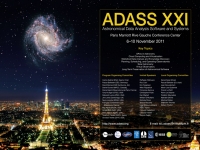Wes Armour (Oxford e-Research Centre, University of Oxford), W. Armour (Institute for the Future of Computing, Oxford Martin School, Oxford e-Research Centre, 7 Keble Road, Oxford OX1 3QG),
A. Karastergiou (Astrophyics, University of Oxford, Denys Wilkinson Building, Keble Road, Oxford OX1 3RH),
M. Giles (Oxford e-Research Centre, 7 Keble Road, Oxford OX1 3QG),
C. Williams (Oxford e-Research Centre, 7 Keble Road, Oxford OX1 3QG),
A. Magro (Department of Physics, University of Malta, Msida MSD 2080, Malta),
K. Zagkouris (Astrophyics, University of Oxford, Denys Wilkinson Building, Keble Road, Oxford OX1 3RH),
S. Roberts (Department of Engineering Science, University of Oxford, OX1 3PJ),
S. Salvini (Oxford e-Research Centre, 7 Keble Road, Oxford OX1 3QG),
F. Dulwich (Oxford e-Research Centre, 7 Keble Road, Oxford OX1 3QG),
B. Mort (Oxford e-Research Centre, 7 Keble Road, Oxford OX1 3QG),
Abstract
Astrophysical radio transients are excellent probes of extreme physical processes originating from compact sources in our Galaxy and beyond. Radio frequency signals emitted from these object provide a means to study the intervening medium through which they travel, via the processes of dispersion, scintillation and scattering.
Next generation radio telescopes are designed to explore the vast unexplored parameter space of high-time resolution astronomy, but require HPC solutions to successfully process the enormous volumes of data that are produced by these telescopes. We have developed a combined software/hardware solution to real-time searches for millisecond radio transients, code-named ARTEMIS, which is based on the PELICAN data pipeline and uses GPU technology to solve the problem of removing interstellar dispersion in order to detect millisecond radio bursts from astronomical sources in real-time.
Here we present a brief introduction to GPUs and their application to the particular problem we are faced with. This is followed by a description of the LOFAR instrument we are using. The physical process of dispersion is discussed along with techniques for removing the dispersive effects of the interstellar medium, traditionally applied to observations of radio pulsars. We describe the ARTEMIS project, its aims and current status. Optimisations and modifications of early GPU implementations of the dedispersion algorithms are presented. Finally, we present two brute-force de-dispersion algorithms, the first using the new Fermi L1 cache and the second based on a shared memory implementation. These new algorithms achieve far greater throughput of the brute-force de-dispersion search algorithm on a GPU which will be needed to discover fast radio transients with unknown dispersion properties in real-time.
Slides in PDF format
Paper ID: O02
|

